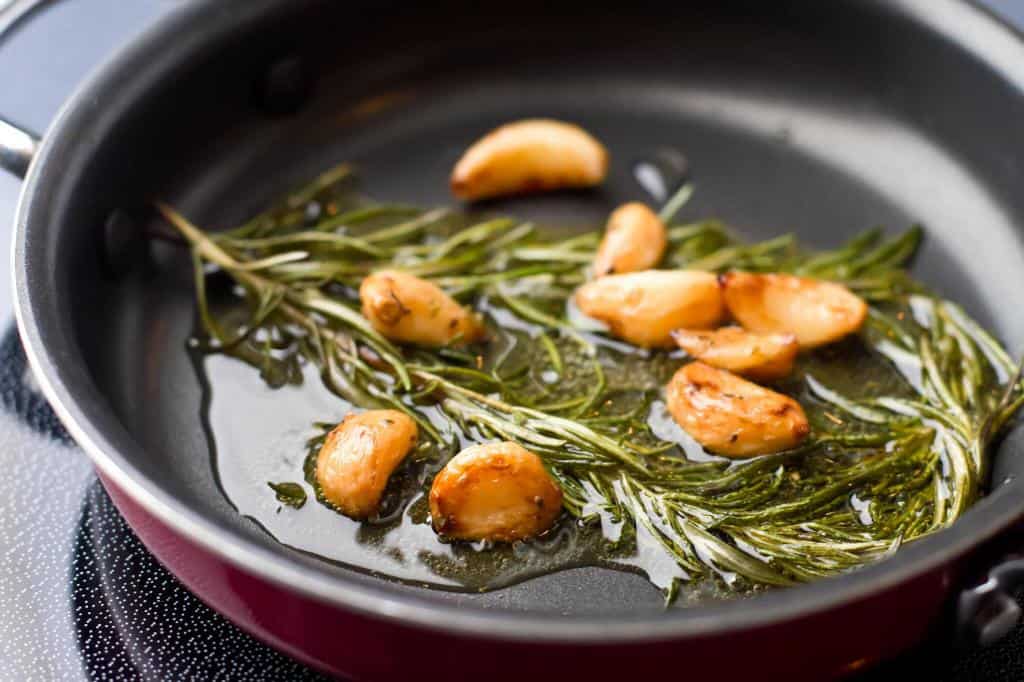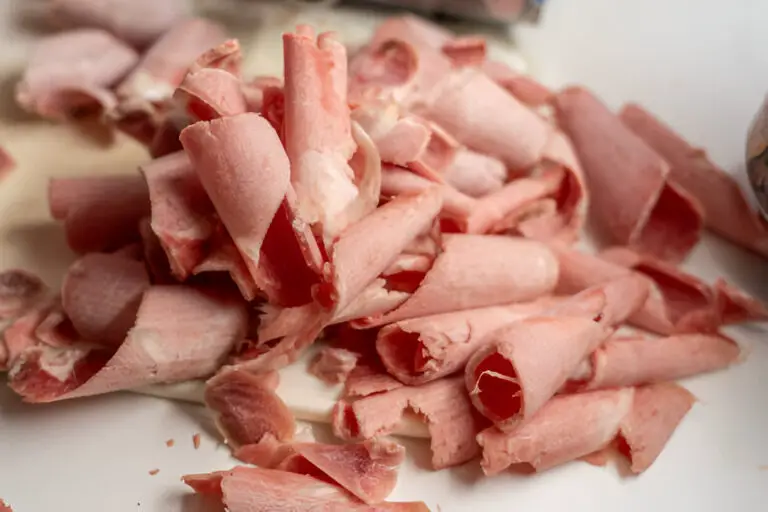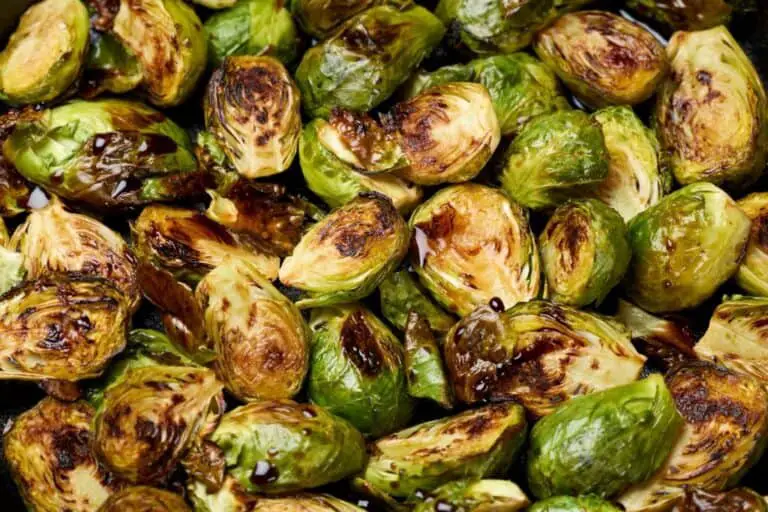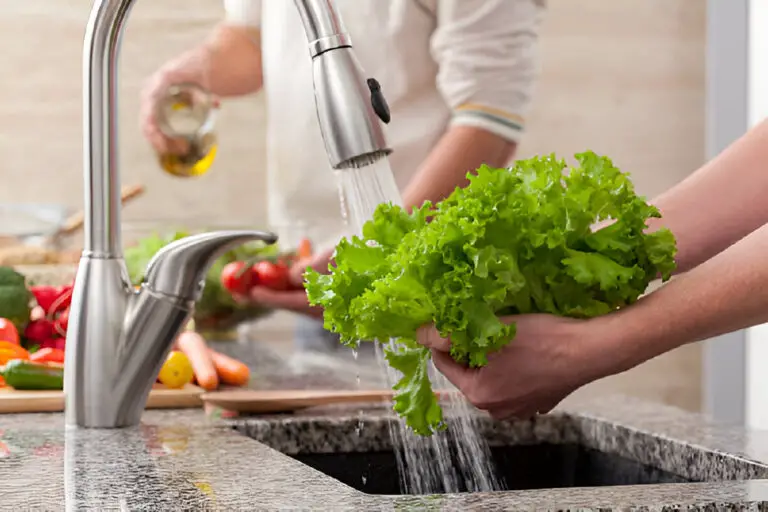Can You Safely Cook with Olive Oil in a Cast-Iron Skillet?

In this brief guide, we are going to answer the question, “Can you cook with olive oil in a cast-iron skillet?” with an in-depth analysis of whether or not you can cook with olive oil in a cast-iron skillet. Moreover, we will have a brief discussion about how to use olive oil to season a cast-iron skillet as well as what smoking is.
Seasoning skillets is an important technique for every cast iron chef to learn. When oils are heated, they react with the cast-iron pan’s surface, leaving a protective layer known as seasoning. Seasoning a pan prevents it from rusting while also providing a non-stick cooking surface.
Are you wondering if you can cook with olive oil in a cast-iron skillet? You need not worry. We will answer all your questions.
So without much ado, let’s dive in and figure out more about it.
Can You Cook with Olive Oil in a Cast-Iron Skillet?

Yes, you can cook with olive oil in a cast-iron skillet. Olive oil is well-known and common. It is found in many stores. So, it might be a popular choice for flavoring cast iron cookware. Olive oil is fantastic for salad dressings, but it’s not so great for seasoning cast iron due to its low smoke point. Seasoning oils with a high smoke point are the best.
This implies that they only start to smoke (or burn) when the temperature rises above a certain point. Olive oil, for example, has a smoke point of 350 degrees Fahrenheit. Canola oil’s smoke point is 400 degrees Fahrenheit.
When cooking in cast iron, a little oil should be added to the pan before adding the food. This prevents the food from sticking and allows for the development of spice layers. As long as the cooking temperature is below the oil’s smoke point, you can use whatever oil you like.
Olive, vegetable, sunflower, and grapeseed oils are all great for cooking. You can use them for everything from sautéing to baking.
Benefits of Using Olive Oil in a Cast-Iron Skillet
Cooking with olive oil in a cast-iron skillet has many benefits. These include better flavor and health perks:
- Heart-Healthy Fats: Olive oil is rich in heart-healthy fats. These fats, called monounsaturated, can lower bad cholesterol.
- Flavor Enhancement: The skillet’s heat enhances olive oil’s flavors. This results in a more robust taste in your dishes.
- Healthier Cooking Option: Olive oil is a healthier alternative to other cooking oils. Extra virgin oil is better for pasta compare to pure oil. It is, making a great choice for those looking to cook with healthier fats.
Choosing the Right Olive Oil
- Extra Virgin Olive Oil: Ideal for recipes that require minimal cooking or as a finishing drizzle over dishes due to its low acidity and unrefined nature.
- Regular Olive Oil or Light Olive Oil: Suitable for higher heat cooking methods like sautéing or frying in a cast-iron skillet.
Considerations When Selecting Olive Oil
- Smoke Point: Choose olive oil with a higher smoke point for high-temperature cooking to prevent burning and off-flavors.
- Flavor Profile: Experiment with various olive oils to add new flavors to your dishes and boost the nutritional value with healthy fats.
How to Use Olive Oil to Season a Cast-Iron Skillet
Seasoning a cast-iron skillet is essential for preventing rust and creating a non-stick surface. Follow these steps to properly season your cast iron skillet using olive oil:
- Clean the Skillet: Remove any burnt food, rust, or residues of the old layer of seasoning by washing or scrubbing them away with hot water. Avoid using soap, as it can strip away the seasoning.
- Dry Thoroughly: After cleaning, thoroughly dry the skillet with a clean towel to remove any moisture.
- Apply Olive Oil: Apply a thin layer of olive oil to the entire surface of the skillet, including the sides and handle. Use a paper towel to spread the oil evenly and remove any excess.
- Preheat the Oven: Preheat your oven to the specified temperature for seasoning (usually between 300 and 400 °F).
- Bake the Skillet: Place the oiled skillet upside down on the top shelf of the oven to catch any drips. Bake the skillet for at least one hour to allow the oil to polymerize and form a protective layer on the surface of the skillet.
- Repeat the Process: For best results, do the seasoning process 3–4 times. Let the skillet cool completely between each application.
- Cool and Store: Once the skillet has been seasoned, allow it to cool completely before storing it in a dry place. Avoid storing the skillet in a humid environment, as this can lead to rust.
| Read: Reusing Old Oil: Can You Get Sick From It? |
What Is the Smoking Point?
A smoking point is defined as the point at which an oil begins to generate smoke, signaling the release of fatty acids.
The oil or fat begins to dissolve into fatty acids as the temperature rises. The time and intensity of the heat to which each cooking oil is subjected determine its smoke point.
Because seasoning necessitates high temperatures, oils with greater smoke points are recommended. The food-grade oil will be put over a cast-iron pan and roasted to a temperature above its smoking point.
This is what causes free radicals to be released, resulting in a thicker coating on the pan’s surface. The key to making a good seasoning oil is to use “drying oils.” They have a better ability to form a strong bond with iron.
Alternative Oils for Cooking in Cast-Iron Skillets
When it comes to cooking in cast-iron skillets, olive oil is often the go-to choice. However, there are several alternative oils that can be just as effective and flavorful when used in combination with or instead of olive oil.
1. Avocado Oil
High Smoke Point: Avocado oil has a high smoke point, like olive oil. This makes it good for high-heat cooking like sautéing or searing.
Light Flavor Profile: It has a light flavor. It complements many dishes cooked in cast iron. It adds a subtle richness to the food.
2. Coconut Oil
Distinct Tropical Taste: Coconut oil adds a distinct tropical taste to dishes while providing a rich texture, making it ideal for stir-fries or desserts prepared in a cast-iron skillet.
Health Benefits: It is praised for its potential health benefits due to its medium-chain triglycerides (MCTs), making it a favorable option for those looking to add variety to their cooking oils.
3. Toasted Sesame Oil
Nutty Flavor Profile: For those seeking a nutty flavor profile, toasted taste sesame oil is an interesting choice when cooking in cast iron.
Lower Smoke Point: It has a lower smoke point compared to other oils mentioned but can be combined with higher heat oils like avocado or grapeseed oil for stir-frying or adding depth to Asian-inspired dishes.
4. Grapeseed Oil
Neutral Flavor: Grapeseed oil has a neutral flavor. This makes it right for many dishes without overpowering their flavors.
High Smoke Point: It has a high smoke point, similar to avocado oil, making it ideal for high-heat cooking methods like frying or searing.
5. Canola Oil
Versatile and Mild: Canola oil is versatile and mild. It can be used for a wide range of cooking techniques, such as baking, frying, and sautéing.
High Smoke Point: It has a high smoke point, making it suitable for high-temperature cooking in cast-iron skillets without burning or smoking excessively.
6. Peanut Oil
Distinct Flavor: Peanut oil has a distinct flavor. It adds a nutty taste to dishes, making it popular for stir-fries and Asian recipes.
High Smoke Point: It has a high smoke point, similar to grapeseed and avocado oils, making it suitable for high-heat cooking methods.
| Also see: Olive Oil, Chia Seeds, and Cayenne Pepper: Combinations for Many Benefits |






